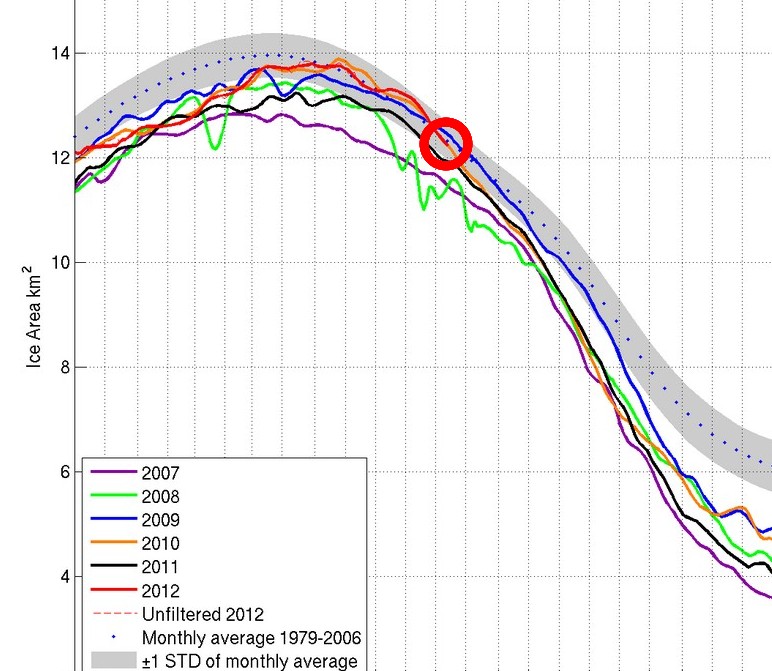By Joe Romm on Sep 22, 2010 at 6:26 pm
Serreze: “I stand by my previous statements that the Arctic summer sea ice cover is in a death spiral. It’s not going to recover.”
Disrupting the Borg is expensive and time consuming!
Google Search
-
Recent Posts
- Fact Checking NASA
- Fact Checking Grok
- Fact Checking The New York Times
- New Visitech Features
- Ice-Free Arctic By 2014
- Debt-Free US Treasury Forecast
- Analyzing Big City Crime (Part 2)
- Analyzing Big City Crime
- UK Migration Caused By Global Warming
- Climate Attribution In Greece
- “Brown: ’50 days to save world'”
- The Catastrophic Influence of Bovine Methane Emissions on Extraterrestrial Climate Patterns
- Posting On X
- Seventeen Years Of Fun
- The Importance Of Good Tools
- Temperature Shifts At Blue Hill, MA
- CO2²
- Time Of Observation Bias
- Climate Scamming For Profit
- Climate Scamming For Profit
- Back To The Future
- “records going back to 1961”
- Analyzing Rainfall At Asheville
- Historical Weather Analysis With Visitech
- “American Summers Are Starting to Feel Like Winter”
Recent Comments
- Gordon Vigurs on Fact Checking NASA
- Bob G on Fact Checking NASA
- Bob G on Fact Checking The New York Times
- Bob G on Fact Checking The New York Times
- Bob G on Fact Checking The New York Times
- Bob G on Fact Checking The New York Times
- arn on Fact Checking The New York Times
- conrad ziefle on Fact Checking The New York Times
- arn on Fact Checking The New York Times
- Bob G on Fact Checking The New York Times



….because the frozen, lifeless arctic is the “living” arctic, and a thawed, greening arctic is dead.
I beg to differ with Mr. Serreze, I think that, there’s life in the old Arctic sea ice yet, it bounds back like a dawg dude. And it sure is still colder than a witches t*t up in them there parts, yessiree.
Extract from the book (2009) „How Spitsbergen heat the world“ :
“But Mark Serreze says: the Arctic is screaming. Is it impossible to find out? It should not be impossible, as the present arctic warming since 1980 is not the only one. There was another
warming period for the region north of 62o North since 1920 until 1945, for which the high-latitude temperature increase was stronger in the late 1930s early 1940s than in recent decades (Polyakov, 2002). The first Arctic warming started 90 years ago, from about 1920 to 1940. In winter 1918-19 the air temperatures exploded at the remote archipelagos Spitsbergen, which the Norwegian call: Svalbard. In 1930 the Norwegian scientist .B. J. Birkeland regarded the rise as maybe the biggest ever observed in one place. Birkeland could presumably repeat the claim today with justification. But would he or his colleagues come up with the exclamation the Arctic is screaming today? Definitely not, although he and his colleagues might wish to scream: How could it be that you know so little about “our arctic warming” to understand “your arctic warming”. Read more: http://www.arctic-heats-up.com/chapter_1.html
I believe the “death spiral” he refers to, that can be done on ice, is this one –
http://en.wikipedia.org/wiki/Death_spiral_(figure_skating)
My question is why not?
Is it because of the ‘hot’ air temperatures?
Sea currents?
Wind?
Soot?
[……fill in any reason……]
I for one stand by my assertion that the Arctic will recover as long as man-made soot is reduced. My computer model tells me so.
It sounds like this clown is in bed with Tim Flannery and full of –it
North Pole Could Be Ice Free in 2008
“The set-up for this summer is disturbing,” says Mark Serreze, of the US National Snow and Ice Data Center (NSIDC).
A number of factors have this year led to most of the Arctic ice being thin and vulnerable as it enters its summer melting season.
http://abcnews.go.com/Technology/story?id=4728737&page=1#.T6cSUu2EYqY
I have been following the Alaskan area temperatures every day. I don’t know where all this ice melt in the Bering Sea is coming from, as temps in that area have remained consistently below freezing. Maybe a warm current? I am skeptical. Stilll subzero F in northern Alaska.
Probably being blown out by wind and shifted by currents. The current doesn’t even need to be abnormally warm. It just needs to move the ice into naturally warmer waters. (Although a warmer current would accelerate the process of course.)